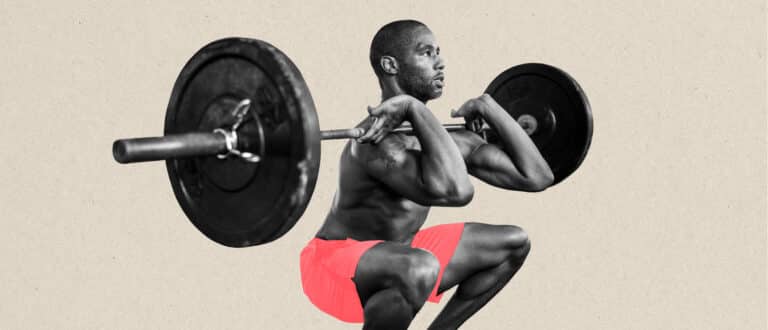This One Workout is What Trainers Swear Boosts Metabolisms
After smashing any workout, you feel sore, happy, confident, and accomplished. As you should.
Still, if you’re unsure whether that workout will yield the exact results you seek and you’re nodding along as you read this, that’s understandable.
There’s a multitude of workout splits, classes, and regimens claiming to burn fat, build muscle, and elevate performance, but your body’s response to those training styles can vary greatly.
Sure, any movement will generally rack up benefits, but understanding exactly how to tap into your metabolic system can yield a massive shift in results.
Metabolic workouts improve your metabolic efficiency by using a specific blend of intensity along with time and rest intervals.
Whether you’re looking to cut down your mile time or improve your body composition, metabolic training offers a specific protocol to help you move the needle. Here’s how.
What is a Metabolic Workout?
A metabolic workout, or metabolic conditioning or metabolic training, is designed to elevate your heart rate, increase calorie burn, and build muscle in less time than your average strength or cardio session.
It involves:
- Multi-joint, compound exercises (targeting multiple muscle groups)
- Moderate to high-intensity effort
- Set work and rest intervals (based on your fitness goals)
To qualify, a workout must include short bursts of moderate to high-intensity work followed by periods of rest. “With the increase in work intensity, workout time decreases,” explains James King III, CSCS, which means sessions cap out at around 20 minutes tops.
Metabolic workouts take on many forms. They’re typically a circuit workout, moving from one compound exercise to the next. Other popular formats include HIIT (high-intensity interval training), Tabata, EMOM (every minute on the minute), and AMRAP (as many reps as possible) workouts.
Metabolic conditioning (Metcon) workouts are CrossFit’s hellish iteration—involving WODs peppered with a variety of multi-joint exercises, sprints, and all-out efforts.
Benefits of Metabolic Workouts
You can amass several benefits from a regular metabolic routine. Note: this isn’t a wonder pill; the benefits only apply if you consistently practice metabolic workouts. Here, a few.
Boost Metabolism
Metabolism is by definition, the process of converting fuel (what you eat and drink) into energy. Muscle burns more calories than fat, even when your body is at rest. That means as you build muscle, your body becomes a fat-burning machine.
Build Muscle
Metabolic workouts incorporate exercises like squats, deadlifts, and pushups which light up large muscle groups, maximizing the muscle fibers used. By targeting more muscle mass, you’ll boost gains.
Improve Cardiovascular Capacity
Metabolic workouts tap into your anaerobic system, your body’s pathway to fuel when it’s short on oxygen. Studies show that anaerobic exercise such as HIIT and circuit training can increase your VO2 max (think: work hard for less effort) beyond a regular steady-state exercise routine (1, 2).
Burn Fat
Metabolic workouts burn a pile of calories, both during and after your workout. How? When you work out at high intensities, your muscles need more fuel than oxygen alone can provide—activating your anaerobic system. Your anaerobic system uses creatine phosphate and glycogen—energy stored in your muscles—for quick energy.
This process taxes your body and puts you in oxygen debt, triggering excess post-oxygen consumption (EPOC). Also known as the after-burn effect, EPOC is a period of time when your body works harder than normal to return to homeostasis, burning tons of calories for energy in the process. One study found that the higher the intensity of your workout, the greater the EPOC effect (3).
How To Do a Metabolic Workout
A merciless Metcon workout may convince you that the point of metabolic training is digging into the dark depths of your body until you’re reaching for the trashcan. That doesn’t have to be the case.
“A well-designed metabolic workout will alternate between different muscle groups to ensure that each muscle group can recover,” says King. He also notes that alternating exercises allows you to maintain maximal workout intensity while prioritizing good form and control throughout the workout.
Crafting your workout to alternate focus between your upper body, lower body, and core, or pushing and pulling movements are a few tricks trainers use to give different muscle groups a rest while keeping your intensity up for the course of the workout.
Best Metabolic Exercises
Exercises can be weighted—using dumbbells, kettlebells, barbells, or other implements like battle ropes, boxes, or medicine balls—or not. Intense bodyweight exercises like squat jumps and plyometric pushups, or all-out cardio work like sprints on the treadmill, rower, or fan bike are fair game.
Here are a few of our favorites that can be done at home with a kettlebell or dumbbells.
- Kettlebell Swings
- Mountain Climbers
- Burpees
- Renegade Rows
- Jump Squats
- Speed Skaters
- Dumbbell Step Ups
- Lateral Lunges
- Pullups
- Pushups
- Deadlifts
- Squat and Press
This isn’t an exhaustive list, and you can sub in exercises that work best for you. Just keep the intensity high, and the weight challenging.
How to Adjust Your Metabolic Workouts as You Get Stronger
Three things you can change to keep your metabolic workouts spicy:
- Duration: If you started with 30 seconds of work, increase your work time to 45 or 60 seconds. The extra work time will tax your muscles and require your body to work that much harder.
- Exercise: Swap new moves into your circuit to mix it up, and be sure to change them out for more advanced variations over time. For example, advance from knee pushups to classic pushups or plyometric pushups.
- Resistance: Continue challenging yourself by gradually increasing your resistance as you get stronger. If you aren’t struggling it’s time to change something, and adding more weight to weighted exercises is a no-brainer.
How to Workout Safely and Avoid Injury
Working out at a high level requires preparing and recovering at a high level, too. Below, our recommendations to keep your system running on all cylinders.
Focus on Form
“Like any type of training, the key is to build up slowly and focus on the quality of your reps first,” says Sam Candler, NASM CPT. By prioritizing rest in between exercises, you’ll maintain good form. Candler promises you’ll end up doing more work in less time with good form on your side.
Always Warmup
Trainers sound like a broken record when it comes to warmups, but they’re on to something. When you’re after top effort, a warmup primes your muscles to give their best. To prep for a metabolic workout focus on dynamic stretches in all three planes of motion. For example, squats, reverse lunges with a twist, and side lunges.
No Ego Lifting
Yes, you want to choose a challenging weight, but challenging for a metabolic workout is different than challenging for a typical strength session. “Make sure you choose the appropriate weight,” says King. “Since the rest periods are shorter, you’ll traditionally use a lighter weight than for formal training.”
Always Cooldown
“Put on some slow jams and end workouts with a soothing stretch,” says King. This will initiate the recovery process and reduce tight muscles.
Take Rest Days
Metabolic workouts do not belong in your daily routine. Rest for 48 hours before training the same muscle groups to allow for sufficient recovery.
If you work out on off days, try low-intensity aerobic exercise like jogging, rowing, or swimming. These are less taxing on the muscles but allow you to stay active and mobile.
Is Metabolic Training Right For You?
“Metabolic training will likely help a client get stronger, but to a point,” says Candler. For example, if you’re training to maximize strength, you’ll benefit from a specialized strength training program that emphasizes quality, heavy reps, and more rest between sets.
It’s also important to consider if metabolic training is the right fit for your lifestyle. “I’ve noticed that my high-stress clients can get even more stressed with too much of an emphasis on metabolic training,” Candler shares. She notes that in her experience those who live a non-stop lifestyle seem to benefit immensely from slowing things down for a while and focusing on one exercise at a time.
Metabolic Training Plan Based on Fitness Level
Throwing exercises together and blowing through a circuit is nowhere near effective. There’s a method to this madness.
Try one of the examples below. Note that the exercises we selected are specifically programmed to alternate between primarily lower body, and primarily upper body or core to give those large muscle groups time to recover between exercises.
Beginner
Focus on building base-level strength and completing high-quality reps before increasing your speed. Modify when needed.
For example:
- 30 seconds Squats, 15 seconds Rest
- 30 seconds Pushups, 15 seconds Rest
- 30 seconds Reverse Lunges, 15 seconds Rest
- 30 seconds Bicycle Crunches, 15 seconds Rest
- 30 seconds Jumping Jacks, 15 seconds Rest
- 30 seconds Shoulder Taps
After completing the circuit, rest as needed. Repeat two to five rounds of the circuit to complete your workout.
Intermediate
Use weighted exercises, multi-level exercises like step-ups, or explosive plyometric exercises to amp up the intensity.
For example:
- 30 seconds Jump Squats, 15 seconds Rest
- 30 seconds Renegade Rows, 15 seconds Rest
- 30 seconds Step-ups, 15 seconds Rest
- 30 seconds Overhead Press, 15 seconds Rest
- 30 seconds High Knees, 15 seconds Rest
- 30 seconds Wood Choppers
After completing the circuit, rest as needed. Repeat two to five rounds of the circuit to complete your workout.
Advanced
As you get fitter, you’ll have to continue mixing up your exercises to see results. One way to do it: try combination exercises like squat to press.
For example:
- 30 seconds Squat to Press, 15 seconds Rest
- 30 seconds Mountain Climbers, 15 seconds Rest
- 30 seconds Speed Skaters, 15 seconds Rest
- 30 seconds Dumbbell Deadlift to Row, 15 seconds Rest
- 30 seconds Plyo Pushups
- 30 seconds Dumbbell Step-ups, 15 seconds Rest
After completing the circuit, rest as needed. Repeat two to five rounds of the circuit to complete your workout.
References
1. Wen, D. et al (2019). Effects of different protocols of high intensity interval training for VO2max improvements in adults: A meta-analysis of randomised controlled trials. https://www.sciencedirect.com/science/article/abs/pii/S1440244018309198
2. Yunus, M. et al (2022). The Effect of Circuit and Interval Training on Maximum Oxygen Volume (VO2max) in Professional Futsal Athletes. https://ejournal.unib.ac.id/index.php/kinestetik/article/view/20801
3. Joao, G. et al (2022). The Effect of High-Intensity Interval Training on post-Exxercise Oxygen Consumption: A Meta-Analysis. https://www.scielo.br/j/rbme/a/Czcp8TbGqtyMgSFr3N98XXF/
















